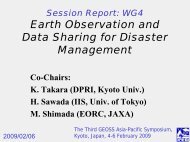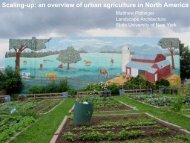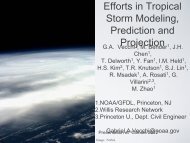Masahiro Watanabe Atmosphere & Ocean Research Institute ...
Masahiro Watanabe Atmosphere & Ocean Research Institute ...
Masahiro Watanabe Atmosphere & Ocean Research Institute ...
You also want an ePaper? Increase the reach of your titles
YUMPU automatically turns print PDFs into web optimized ePapers that Google loves.
<strong>Masahiro</strong> <strong>Watanabe</strong><br />
<strong>Atmosphere</strong> & <strong>Ocean</strong> <strong>Research</strong> <strong>Institute</strong><br />
University of Tokyo<br />
hiro@aori.u-tokyo.ac.jp<br />
Collaborators:<br />
M. Yoshimori, Y. Kamae, M. Kimoto (AORI, Univ of Tokyo),<br />
H. Shiogama, T. Yokohata, T. Ogura, S. Emori (NIES),<br />
J. D. Annan, J. C. Haargreaves (JAMSTEC)
Did climate sensitivity get converged in CMIP5 <br />
Equilibrium climate sensitivity (ECS) to 2xCO 2 in CMIP models<br />
IPCC report FAR SAR TAR AR4 AR5<br />
climate sensitivity 1.5-4.5K 1.0-3.5K 1.5-4.5K 2.1-4.4K <br />
Mitchell et al. (1990), Kattenberg et al. (1996), Cubasch et al. (2001), IPCC (2007)<br />
ECS in 4xCO2 experiments by some of the CMIP5 models<br />
2-4.6 K<br />
@Crown copyright Met Office<br />
Slide courtesy of K Taylor
Model diversity<br />
Structural differences in the multi-model ensemble (MME)<br />
make it difficult to understand sources of uncertainty<br />
CMAP<br />
Annual-mean precipitation biases in CMIP3<br />
MME<br />
IPCC (2007)
Different groups use CMIP MMEs differently<br />
Non-modeling groups tend to compare ensembles (e.g.<br />
CMIP3 vs CMIP5) w/o tracing changes in a particular<br />
model<br />
Modeling groups can do the same, but also trace the<br />
changes across versions of their own model and<br />
attribute difference in the system’s behavior to<br />
physical processes (parameterization details)
Equilibrium climate sensitivity<br />
Gregory plots for 4xCO2 experiments<br />
CMIP3 version<br />
MIROC3med(T42)<br />
2x =3.6K<br />
N = F − α∆T<br />
CMIP5 version<br />
MIROC5 (T85)<br />
2x =2.6K<br />
SAT<br />
SAT<br />
<strong>Watanabe</strong> et al. (2010, JC)<br />
Cloud-shortwave (SWcld) feedback is the key component
Multiple timescales of the cloud feedback<br />
MIROC3.2 MIROC5 4xCO2 150y 150y<br />
HadGEM2-ES 4xCO2<br />
slope in the<br />
natural variability<br />
slope in the<br />
natural variability<br />
CRE [W/m 2 ]<br />
SST [K]<br />
<strong>Watanabe</strong> et al. (2011, Clim. Dyn.)<br />
+ ann. mean, single run (150y)<br />
○ decadal mean, single run<br />
△ ann. mean, ensemble avg (20y)<br />
★ initial month of △<br />
SAT [K]<br />
Courtesy of Tim Andrews<br />
Sign of the SWcld feedback is<br />
determined by the fast response of<br />
clouds during a few years in MIROCs
Fast response of low clouds<br />
4xCO2 runs<br />
(20y ensemble)<br />
Regime composite of low cloud wrt 500<br />
MIROC3<br />
MIROC5<br />
Low cloud amount [%]<br />
Tropical mean < 0 Tropical mean > 0<br />
500hPa <br />
<strong>Watanabe</strong> et al. (2011, Clim Dyn)<br />
CTL<br />
CTL<br />
C<br />
P C ( ) d P C ( )<br />
d<br />
<br />
<br />
l l l<br />
Thermodynamic driving<br />
Tropical-mean changes in C l & SWcld are due to a subtle difference<br />
between C l decrease / increase over the subsidence / ascent regime
ENSO and climate sensitivity<br />
Reasons may be different in the two models, but a<br />
common feature of strong ENSO in the control run low<br />
ECS<br />
MIROC5 PPE-C (JUMP2)<br />
HadCM3 PPE-C (QUMP)<br />
SWcld feedback [W/m 2 /K]<br />
Nino 3.4 SST std dev [K]<br />
Corr=-0.67<br />
Nino 3.4 SST std dev [K]<br />
Equilibrium climate sensitivity [K]<br />
Shiogama et al. (2012, Clim. Dyn.) Toniazzo et al. (2008)
ENSO and climate sensitivity<br />
Compare 10 models having<br />
* Largest negative SWcld feedback<br />
* Smallest negative SWcld feedback<br />
Larger SWcld feedback<br />
Wetter mean state over the central<br />
equatorial Pacific & stronger ENSO<br />
ENSO amplitude [K]<br />
wet cold tongue dry<br />
<strong>Watanabe</strong> et al. (2011, JC)<br />
Shiogama et al. (2012)
Forcing-Feedback in two PPEs<br />
MIROC3 PPE<br />
Multi-Physics Ensemble<br />
(MPE)<br />
CMIP3 MME<br />
Climate<br />
sensitivity<br />
MIROC5<br />
AGCM<br />
MIROC5 MPE<br />
MIROC5 PPE<br />
Structural difference > Parametric difference<br />
Any strategy to link them <br />
Replacing one or more<br />
schemes in MIROC5 w/<br />
old ones:<br />
Std (=MIROC5)<br />
(old)CLD<br />
(old)CUM<br />
(old)VDF<br />
(old)CLD+CUM<br />
(old)CUM+VDF<br />
(old)CLD+VDF<br />
(old)CLD+CUM+VDF<br />
<strong>Watanabe</strong> et al. (2012, JC)
MPE: Filling the gap between PPEs<br />
Climate sensitivity vs SWcld feedback<br />
Processes are nonlinear, e.g.,<br />
Extratropics<br />
Global<br />
Tropics<br />
(old)CLD -> small impact<br />
(old)VDF -> small impact<br />
(old)CLD+VDF -> large impact!!<br />
SWcld feedbacks<br />
STD<br />
CLD+<br />
CUM<br />
CLD+<br />
VDF<br />
<strong>Watanabe</strong> et al. (2012, JC)<br />
‘Feedback occurs thru the interaction of a suite of parameterized<br />
processes rather than from any single process’ (Zhang & Bretherton 2008)
What can we do next<br />
Further analysis to the CMIP5 MME on the cloud<br />
feedback, adjustment, radiative forcing etc.<br />
-> will come out at the CFMIP meeting (May 2012, Paris)<br />
Paris)<br />
Hierarchical modeling to deepen our understanding of<br />
the cloud feedback processes (e.g. Brient & Bony 2012)<br />
Extensive use / coordinated analysis of the PPEs<br />
“Seamless model evaluation” ― Jim Murphy
Similarity in Pattern<br />
Cloud-shortwave forcing (SWcld)<br />
in CMIP5 AMIP 4xCO2 exps<br />
HadGEM2(+0.23W/m 2 ) IPSL CM5A (+1.07W/m 2 )<br />
Change in the tropical<br />
vertical motion in MIROC5<br />
4xCO2<br />
<strong>Ocean</strong><br />
CNRM (+0.85W/m 2 )<br />
MIROC5 (+0.70W/m 2 )<br />
CTL<br />
Land<br />
Courtesy of M. Webb<br />
Roughly positive (warming) over oceans,<br />
negative (cooling) over lands<br />
ω [hPa/s]<br />
Initial spin-up of the Walker cell<br />
due only to 4xCO2
ΔSWcld in idealized experiments<br />
L000(Aquaplanet)<br />
Dependence of ΔSWcld on the land size<br />
L000<br />
L180(continent in w hemi.)<br />
SWcld [W/m 2 ]<br />
L060<br />
L120<br />
Available in CMIP5 MME<br />
L180<br />
L240 L300<br />
SAT [K]<br />
[W/m 2 ]<br />
Land-sea contrast counteracts the cloud<br />
decrease over the tropical oceans and<br />
hence the strong cloud-shortwave forcing
Papers available at http://tinyurl.com/3qfup84 (user: guest, password: miroc)<br />
Concluding remarks<br />
MME is only one of the possible model ensembles<br />
Extensive use of combined various ensembles as well as a<br />
hierarchical modeling approach are desirable for advancing<br />
our understanding of the cloud feedbacks<br />
Hierarchical modeling<br />
Zhang & Bretherson 2008<br />
Medeiros et al. 2008<br />
Brient & Bony 2012<br />
Multi Model Ensemble<br />
Multi Physics Ensemble<br />
Gettelman et al. 2011<br />
<strong>Watanabe</strong> et al. 2012<br />
Perturbed Physics Ensemble<br />
Collins et al. 2010<br />
Yokohata et al. 2010<br />
Sunderson et al. 2010<br />
Klocke et al. 2012<br />
Shiogama et al. 2012
Papers available at http://tinyurl.com/3qfup84 (user: guest, password: miroc)<br />
Summary<br />
Toward understanding sources of model’s “uncertainty”<br />
in terms of the climate sensitivity & climate feedbacks,<br />
We have shown thru the analysis of MIROC3.2/MIROC5/CMIP3<br />
(& CMIP5 later) an importance of:<br />
identifying timescales of cloud response/feedback<br />
distinguishing robust/fragile parts associated w/<br />
cloud response/feedback<br />
Extensive use of various ensembles based on MIROC reveals<br />
a connection between apparently independent<br />
phenomena (ENSO & climate sensitivity)<br />
attribution of inconsistency among GCMs to<br />
individual processes/interactions







